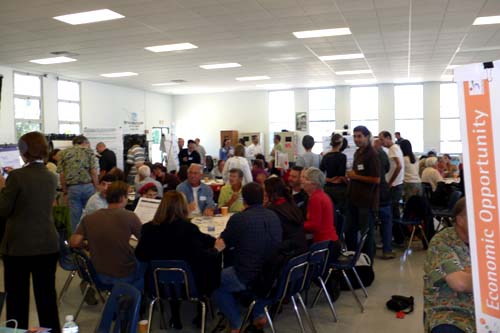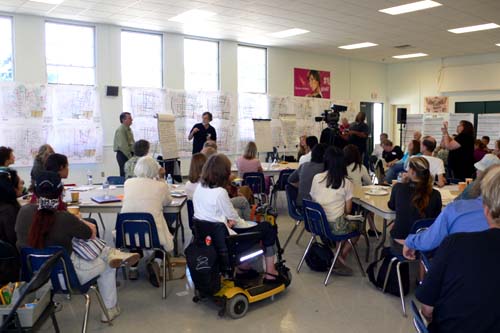
100 Solutions or One?
By Frank Gruber
Twenty-five years from now when activist
Jerry Rubin is an old man and the 100
or so ficus trees that aren't being removed
from Second and Fourth Streets this year
are dying as they reach the ends of their
life spans -- that is if they haven't
died already from disease -- the younger
generations of humans then living in Santa
Monica will be grateful that back in 2007
the City replaced 54 old ficus with 139
gingko saplings.
In a forest, nature sees to it that there
are always trees in different stages of
growth. In an urban forest, people have
to do the job. You can't wait until all
the trees on a street die on their own.
Planting trees is how we give the future
a reason to remember us fondly.
* * *
That was quite a workshop the Planning
Department threw on Saturday on the circulation
element of the general plan. Attendance
was high -- about 140 people registered
-- and nearly all of them stayed the entire
five hours.
Reports of the demise of public interest
in the land use and circulation element
update process (LUCE) seem premature.
There were two components to the workshop.
The first was mutli-part lecture on mobility
in general and in Santa Monica in particular
by Jeffrey Tumlin, the City's consultant.
Much of the lecture was, using Mr. Tumlin's
word, "wonkish," but the audience,
based on the questions they asked, ate
up Mr. Tumlin's theories, concepts and
data.
The second component was "table
work" during which participants working
in small groups both evaluated different
approaches identified by Mr. Tumlin and
formulated their own proposals and ideas.
They marked up big maps of the city, which
later were displayed around the room,
and presented their ideas at the end of
the day.
 |
| Photos
by Frank Gruber |
As I mentioned above, there was nothing
simplistic about Mr. Tumlin's talk. It
was so not simplistic that it's hard for
me to summarize it here. Suffice it to
say that he dug deeply into all the factors
that cause traffic congestion in Santa
Monica, and suggested actions that the
City could take, realistically, to alleviate
the problem if not "solve" it.
These actions did not involve simply
making cars move faster. In fact, he argued
that the City's bigger goals at times,
on certain streets, could be better served
by slowing traffic. Mr. Tumlin's advice
was to focus as much or more on quality
of life and "accessibility"
rather than "mobility." As he
pointed out, mobility is itself not a
goal, but a means to achieve ends -- to
"access" them.
In other words, if the problem is how
long it takes to get somewhere, the problem
can be solved either by speeding up the
journey (the traditional approach that
has created the current untenable situation)
or by bringing the destination closer
to the starting point.
What was interesting about Mr. Tumlin's
analysis was how well residents "got
it." We're so used to the dialogue
about traffic in Santa Monica being dumbed
down by the regulars who attend City Council
meetings -- and sometimes by council members
themselves (remember "it's the traffic,
stupid"?) -- that it was almost shocking
to see how sophisticated Santa Monicans
are.
Although not really. Whenever a large,
representative group of residents come
to a LUCE event, going back to the very
first event that occurred in January 2005
in the same cafeteria at John Adams Middle
School, they show a much more subtle grasp
of urbanism than the sloganeering and
vitriol that typifies the testimony at
council meetings.
An example of the dumbing down of the
discussion about traffic in Santa Monica
is the controversy over how the City measures
traffic. This issue, which seems as if
it should be technical, has become political.
Anti-growth groups like the Santa Monica
Coalition for a Livable City have argued
that the City's efforts to evaluate traffic
flow at intersections during peak periods
do not capture the enormity of the traffic
problem in Santa Monica, and that therefore
until the City has counted every car (more
or less), the City should not allow more
development.
Mr. Tumlin's analysis turned the issue
on its head. What he pointed out is that
the City's analysis of traffic, which
solely evaluates the movement of cars,
fails not because it doesn't count enough
cars, but because it doesn't evaluate
anything else -- such as movement by other
means, or by the impact on the environment
of different transportation alternatives.
The City's overall goal is to be sustainable,
but the City, when it comes to transportation,
only measures travel by car, the least
sustainable alternative. Counting more
cars isn't going to solve anything.
Streets, for instance, are only evaluated
by how many cars they are expected to
accommodate ("arterial, collector,
feeder, local"), not by their other
functions (retail, residential, industrial,
etc.). A single-passenger car is counted
the same as a 40-passenger bus as it goes
through an intersection.
Meanwhile, by focusing on cars and how
fast they get through intersections, the
City ignores the duration of a trip, which
is more important than its speed. If my
supermarket is less than a quarter mile
away, I don't care if I have to wait a
minute for a green at the one big intersection
between it and me.
As I said, the Santa Monicans at the
workshop ate this up. Their ideas elaborated
on the "metrics" needed to measure
mobility holistically. But then this isn't
surprising, given the history. If you
go back and read the City's 1984 general
plan, you'll find that the goal even then
was to reduce miles traveled by car.
At the end of the workshop, I was left
with only one suggestion. As one participant
had said in a comment, the employees who
commute into Santa Monica, and who create
(and suffer from) our worst traffic congestion,
were not present.
When you think about it, it's the commuters
who are crucial to improving mobility
and accessibility in Santa Monica. Our
traffic problems reach their peak in the
afternoon when thousands of them leave
the city in all directions.
The planners need to hear from these
commuters about what transportation services
they need that would get them out of their
cars, and for the benefit of them and
us, the City needs to design future transit
with their needs in mind. And there is
no reason to wait for Expo rail or the
Subway to the Sea.
Mr. Tumlin said many things, but one
summarized everything. He offered no magic
bullet, no big solution. He said there
was none. But that didn't mean we were
helpless. We can still improve the quality
of our mobile lives, even in a changing
world.
What he said was that "one big solution
will not work as well as 100 small solutions."
Amen to that.
|


